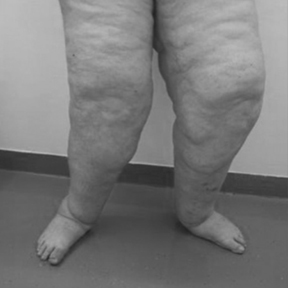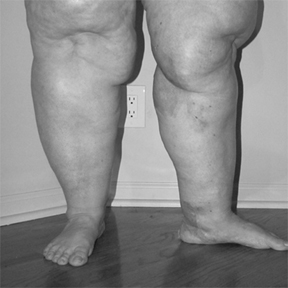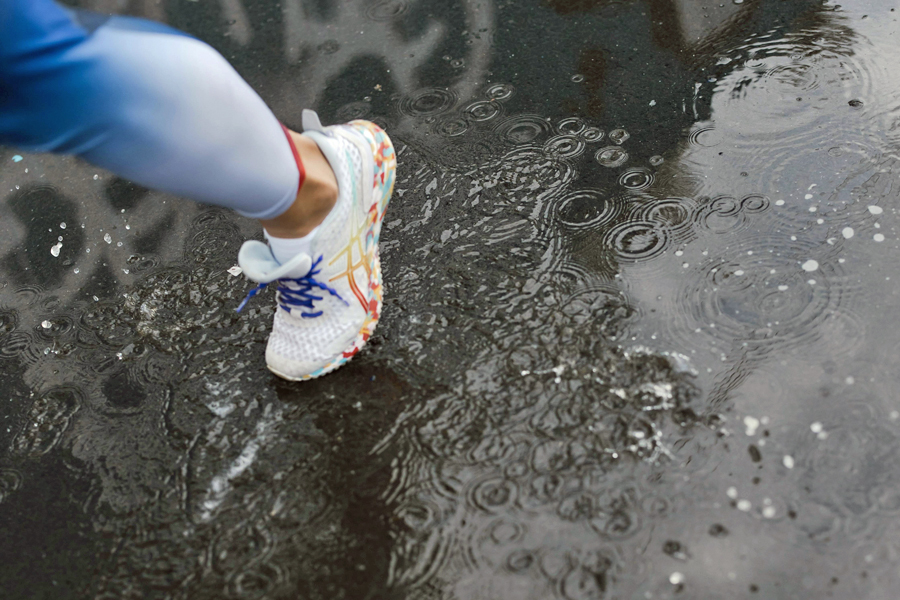Lipedema presents as abnormal, symmetrical accumulations of painful nodules of fat on the legs, anywhere from buttocks to ankles and especially on the inside of the thighs, although there are several places where it develops, and these are termed the types of lipedema. This excess fat causes affected patients to develop a characteristic gait. To avoid the legs rubbing together and damaging the skin, patients tend to spread the feet while walking.
Lipedema often leads to various foot and ankle issues. Common foot disorders associated with lipedema include ankle pain and flat feet. The heavy fat deposits around the ankles can cause pain and weakness, especially when walking or standing for extended periods. The increased weight and potential for joint issues can contribute to the development or worsening of flat feet.
Lipedema can affect the muscles around the ankles and feet, including the quadriceps, gastrocnemius, and Achilles tendon, leading to weakness and reduced mobility. The fat deposits can constrict blood vessels in the ankles, leading to reduced blood flow and potential discoloration. The increased fat and potential joint issues can limit flexibility in the ankles and thighs, and the increased weight and strain on the joints can lead to pain, inflammation, and even arthritis in some cases. The fat buildup with lipedema can cause joint problems, including knock knees.
Lipedema can lead to altered weight distribution and increased stress on the plantar fascia, the tissue band on the bottom of the foot — this can trigger or worsen plantar fasciitis, a common cause of heel pain, which can be exacerbated by lipedema’s impact on gait and foot mechanics. The excess fat can also cause weakness in the quadriceps and Achilles tendon, reduced blood circulation in the ankles, and decreased flexibility in the ankles and thighs.
Patients notice an increase in the size of the legs and believe that any joint pain they experience is due to accompanying weight gain. As the lipedema nodules continue to accumulate, this pushes the legs further apart, and the misaligned joints become clinically relevant. The improper gait causes a valgus deformity in the knee joints and a “skew-foot” position of the ankle joint (see below), along with pronation of the feet and a shift in the hip joint. There are a few patients who develop a varus gait (see below) due to especially enlarged fat pads in the inside of the knees.

Valgus Gait With Pronated Foot

Varus Gait With Pronated Foot
These abnormal gaits create wear on the joints, to the point that hips, knees and ankles are adversely affected, even going as far as to cause meniscal and ligamental tears. Add to that the weight of the lip nodules and lymph fluid caught within the tissues combined with affected joints, and mobility is extremely compromised in the late stages of the disease. Many patients develop an inability to stand or walk for even short periods of time, severely impacting their employment, instrumental activities of daily living (such as communication, food preparation, housekeeping, laundry managing finances or medications, shopping, and transportation), and activities of daily living (dressing, eating, hygiene, etc.). Many patients become disabled and must file for disability.
Structural function of the foot.
The architectural structure of the foot is often referred to as the plantar vault, which blends all elements of the foot — joints, ligaments, bones and muscles — into a unified, adaptable system. This structure creates the arch, curvature, and elasticity crucial to weight distribution, foot flexibility, shock absorption, and adaptable shape of the plantar side (sole) of the foot to the surface it encounters when walking. It adapts to ground forces in relation to weight and terrain for the best mechanical advantage. Exaggeration or flattening of the foot curvature compromises the support necessary for walking and maintaining proper body alignment.
How is function assessed?
Activities of daily living (ADLs) are a series of basic activities necessary for independent living at home or in the community which are performed on a daily basis.
There are nine areas of ADLs used in occupational therapy:
— Bathing and showering
— Toileting and toilet hygiene
— Dressing
— Feeding
— Eating and swallowing
— Functional mobility
— Personal device care
— Personal hygiene and grooming
Instrumental activities of daily living are similar to ADLs. These actions are important to being able to live independently but are not necessarily required on a daily basis. IADLs are not as noticeable as ADLs when it comes to loss of functioning, but functional ability for IADLs is generally lost before ADLs. IADLs can help better determine the level of assistance needed by an elderly or disabled person. IADLs include:
— Basic communication skills
— Transportation
— Meal preparation
— Shopping
— Housework
— Managing medications
— Managing personal finances
The Katz Index of Independence in Activities of Daily Living is a good means to assess functional status as a measurement of a patient’s ability to perform activities of daily living independently.
A functional capacity evaluation (FCE) evaluates a patient’s capacity to perform work activities related to his or her participation in employment. The FCE process compares the health status and body functions and structures to the demands of the job and the work environment. An FCE’s primary purpose is to evaluate an ability to participate in work, although other instrumental activities of daily living that support work performance may also be evaluated. FCEs are usually conducted by occupational therapists, based on their education and training.
The FCE may be used to determine:
— Goals for rehabilitation or readiness for discharge planning
— Ability to safely return to work status
— Work ability status for vocational rehabilitation
— Workers’ compensation case settlement
— Disability status
— Ability to meet job demands as part of a hiring process
— Ability to meet the demands of other activities
The components of the FCE will vary based on the purpose of the assessment. The FCE typically begins with a client interview, medical record review, and musculoskeletal screening. Functional testing may include graded material-handling activities such as lifting, carrying, pushing and pulling, and positional tolerance activities such as sitting, standing, walking, balancing, reaching, stooping, kneeling, crouching, crawling, object manipulation, fingering, hand grasping and hand manipulation. Pain monitoring is frequently performed during the FCE to document patient-reported levels of pain during various activities as well as to manage pain. The FCE may also include evaluation of an individual’s hand dexterity, hand coordination, endurance, and other job-specific functions.
The FCE report includes an overall physical demand level, a summary of job-specific physical abilities, a summary of performance consistency and overall voluntary effort, job match information, adaptations to enhance performance, and treatment recommendations if requested. FCEs are done on a one-on-one basis and may range in length from 4 to 6 hours. The FCE may take place over 2 consecutive days.
Dunkin, M., Burtka, A., & Mitchell, K. (2023). What is lipedema? Web MD.
Functional capacity evaluation. (n.d.). American Occupational Therapy Association.
Most commonly experienced mobility issues caused by lipedema. (n.d.). Soft Touch Mastectomy & Lymphedema Care.
Stutz, J., & Wald, S. (2011). Liposuction of lipedema to prevent later joint complications. Vasomed.
Additional Information
Activities of daily living Continuing Education Activity | National Library Of Medicine
Functional capacity exams and balance testing PODCAST | Brooks Rehabilitation
How lipedema can cause mobility issues | Dr. Thomas Wright
Liposuction of lipedema to prevent later joint complications PDF | Dr. Josef Stutz
Lower extremity functional scale PDF | Emory Healthcare
Occupations and everyday activities | American Occupational Therapy Association
The physical and emotional effects of lipedema VIDEO | Dr. Josef Stutz
What to know about ADLs and IADLS | Very Well Health





